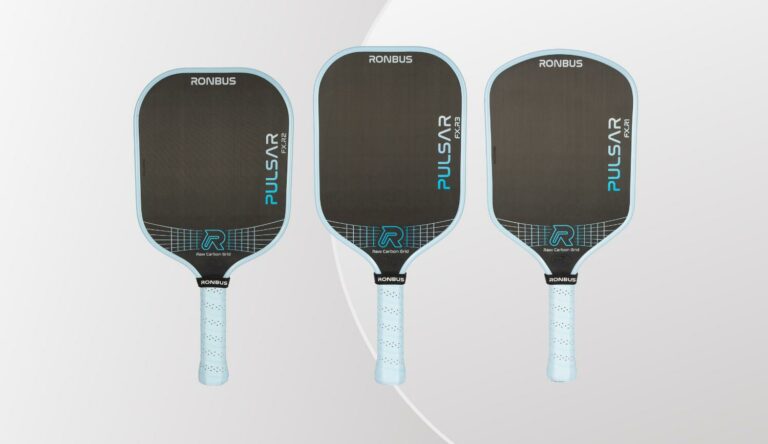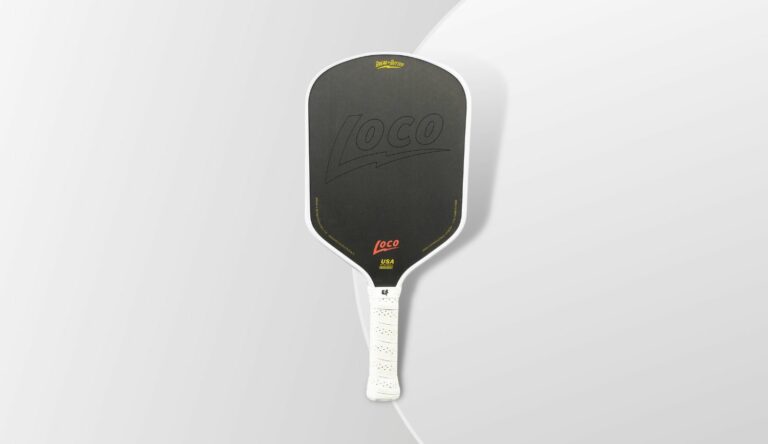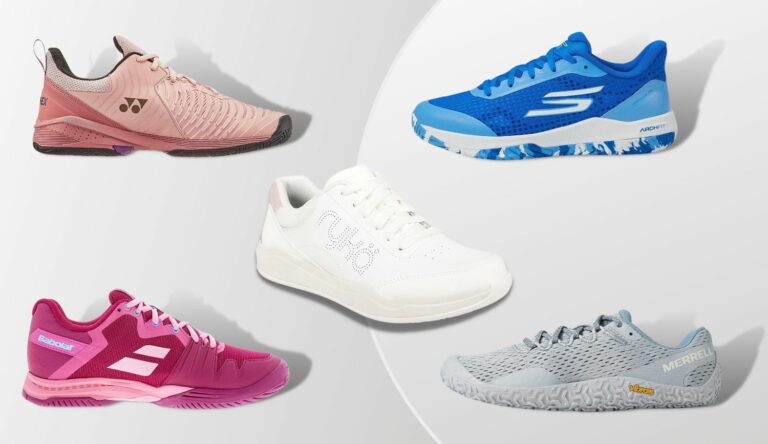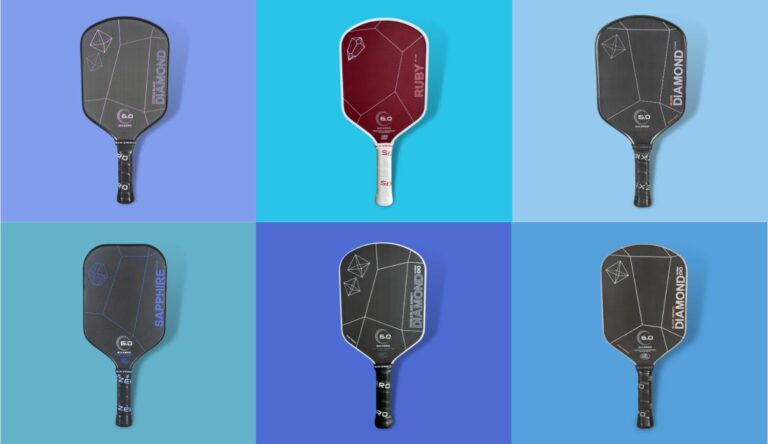Six Zero, an Australian paddle manufacturer, exploded onto the pickleball scene in 2023. They have an excellent line of paddles, which features the Black Diamond, Double Black Diamond, and Sapphire paddle lines.
In this post, I’ll be doing a thorough comparison of the Black Diamond Power 16mm (Full review) and the Double Black Diamond Control 16mm (Full Review).
This article’s primary focus is to compare the 16mm version of these paddles, but I will also cover how the Black Diamond stacks up against the 14mm Double Black Diamond (Full review).
I will be referencing these paddles by their abbreviated names throughout this article.
- BD stands for Black Diamond
- DBD stands for Double Black Diamond
If you decide you’d like to buy either (or both) of these paddles, you can get 10% off your order at Six Zero’s website using code DASHPB.
Let’s dive into the review.
Contents
Black Diamond 16mm vs. Double Black Diamond 16mm Quick Summary
I’ll start by saying that both of these paddles are absolutely stellar options.
You really can’t go wrong with either paddle, unless you’re a true beginner, and then the Black Diamond will likely be a bit too hot to handle.
The shape and overall structural components of the BD and DBD are the same. They’re both thermoformed paddles with honeycomb cores and 5.5″ handles. As such, they will feel very similar in hand. You can read about each paddle in depth in my individual paddle reviews.
The main differentiating factor between these two paddles comes down to the paddle face.
- The Double Black Diamond’s face is raw carbon fiber, which has become the de facto face material for thermoformed paddles. It has a good all-around feel when contacting the ball.
- The Black Diamond’s face utilizes a composite fiberglass material, which provides the BD with significantly more power and pop.
The Double Black Diamond has been the far more popular paddle so far. This is partially because of hype, but also because it was the first Gen. 2 thermoformed paddle that was made specifically with control in mind, making it the defacto choice as the all-arounder thermo king.
The Black Diamond provides more power than the DBD, which certainly appeals, but its first production runs were also very hard to tame. This paired with its unique feeling fiberglass face resulted in many players deciding to opt for the easier-to-control DBD, which is understandable.
That said, I believe that the BD is going to experience a surge in popularity in the coming months. This is because the most recent runs of the Black Diamond (from July onwards) are slightly less powerful and far more controllable.
Dale, the owner of 6.0 has confirmed this, and I can attest to it as well, as I’ve been playing with an April BD and late July BD side by side. I’ll be discussing this more throughout the article.
Now, let’s dive into specific comparisons.
Power Comparison
The BD and DBD both have plenty of power on deck. They can both be weapons and will make any player’s drives, serves, and counters much more deadly than those made with a non-thermoformed paddle.
The Black Diamond is a power paddle, so it of course has more power than the DBD control. The drives I hit with the BD are intoxicating. You can really put your opponents on their heels in defensive mode with the raw power of the BD in ways that only a few paddles can manage.
As mentioned, the newest run of BDs has slightly less power as a result of manufacturing processes that are controlling for delamination, but the new BD still packs a big punch. Plus, it’s more controllable now, which makes it even more of a weapon.
The Double Black Diamond may be classed as a control paddle, but this thing is still a Gen. 2 thermoform that holds its own in an arms race. I’ve been in contact with multiple players who have bought DBDs from my recommendation, and they’ve relayed to me that opponents are vocal about fearing their drives and serves.
Pop comparison
The BD’s fiberglass face gives it noticeably more pop than the DBD’s raw carbon fiber face, but neither is soft. Both of these paddles are plenty poppy.
Is one better than the other? This is definitely a preference thing. I really dig the extra pop of the BD, but if I didn’t have much of a control game, I probably wouldn’t.
More pop gives you the ability to drive the ball incredibly fast off the face, which makes hand battles extremely fun. But that pop also makes the ball slightly harder to wrangle, which can result in more out balls and popups.
If you don’t want a paddle that’s got a ton of pop, then I recommend the thermoformed Ronbus Pulsar. It’s much more muted and controllable, while still providing the benefits of a Gen. 2 thermoformed paddle.
I will note here that there are production variances with 6.0 (and other thermo) paddles, and some DBDs are not that poppy. I have three, and one of them came softer out of the box. But, in general, both the BD and DBD provide a good amount of pop. Note that the DBD tends to soften up as you play, while the BD stays poppy.
Control Comparison
The DBD is the more controllable paddle of the two. It’s excellent for dinks, drops, resets, and blocks. Like many people, I settled into this paddle quickly and fell in love with its control game.
The original runs of the BD (2022) were super powerful but incredibly hard to control and prone to delamination. The next production batches of BDs were easier to control but still pretty hot. The newest BDs (July 2023 onward) are much more controllable.
I feel that these newest BDs sit at the perfect sweet spot for a power player who wants to drive balls hard but not sacrifice too much in the control department.
And the DBDs are of course still the de facto choice for control-focused players who want a Gen.2 thermoform which has great feel and pop.
I’ll mention once more that these paddles will take some getting used to for non-thermoformed players. The DBD also softens after the first 10 hours of play and settles in more and more as you play with it.
Hand speed Comparison
Both of these paddles provide excellent hand speed due to their shape. There’s really no difference between them in this department. There is a variance in weight, of course, between each paddle that’s made.
BDs and DBDs that are on the lighter end of the spectrum will feel faster in hand, while those on the heavier side will feel a tad slower.
These paddles are plenty fast and I often recommend adding weight to the lower areas of the paddle face to add extra stability and plow-through to these paddles. There are always tradeoffs with weight.
Spin Comparison
The Black Diamond and Double Black Diamond both share the same top-tier spin.
These each grip balls at insane levels, enabling you to shape your shots in ways that you’d never be able to with any paddle manufactured pre-2023.
I absolutely love dinking with topspin with them, my DBD in particular, and sending hard top-spin drives over the net with crazy shape that dip straight to their feet.
My backhand slices with these paddles also are hilarious, as they jump like popcorn away from my righty opponent’s forehands in a way that always cracks me up.
Should you buy the Black Diamond or Double Black Diamond?
So which is better, BD or DBD? Which should you buy?
It really depends on your play style and goals.
You should buy the Black Diamond if:
You’re a power player that loves to hit the ball hard without sacrificing too much control. It’s the best of both worlds for a power paddle.
The BD is an excellent choice over other power paddles, like the ProKennex Black Ace and Selkirk Power Air because you’re getting way more controllability with the BD, especially the newest version.
- You can read more about the Black Diamond paddle in my review here. Or you can buy the Black Diamond now for 10% off here with code DASHPB.
You should buy the Double Black Diamond if:
You’re a player that wants an excellent balance of power and control from your paddle. You’re not worried about having top-level power. You prefer to have the best control available for you without sacrificing too much power.
I love the BD, but the DBD will be the better option for most players. It can be hard to control a thermoformed paddle, and most players would do better to go for the more control-oriented thermoformed DBD to improve their consistency.
- You can read more about the Double Black Diamond paddle in my review here. Or you can buy the Double Black Diamond now for 10% off with code DASHPB.
Should you buy the BD and DBD?
Why stop at just one? If you’re adventurous, competitive, or just a bit of an equipment hoarder, then picking up both the BD and DBD might be the right choice for you.
They each have their strengths, namely the BD as an excellent singles paddle, while the DBD excels in doubles. But both can be used interchangeably across singles and doubles for different reasons.
Which of the two paddles do I use?
It depends on the day, but I prefer to play with the Black Diamond more often. I certainly enjoy the DBD in doubles, but I feel like the BD is slept on, especially the newest iteration.
While I still love to play with my older BDs, the newest one is one of my favorite paddles. It’s far easier to reign in and the power is just right. It still requires a lot of focus and intention, but that requirement just fuels my game even more.
I love starting a session with a tough singles matchup using my BD, then swapping out to my DBD for some high-level doubles. After dialing in my game with the BD, using the DBD feels effortless and my game always feels on-point for those matches.
What about the Black Diamond vs the 14mm Double Black Diamond?
The 14mm DBD (full review) came on the scene after the original 16mms of the BD and DBD were released. The 14mm is less popular than its 16mm brother, but it’s an excellent paddle in its own right.
I find the BD and DBD to feel pretty similar. Both are certainly very poppy. The 14mm DBD moves more quickly and feels best for hand battles. But the 16mm BD feels more stable and powerful.
Control-wise, they each have their strengths. As mentioned, the BD feels more stable. I prefer blocks with the BD over the 14mm DBD. But it’s also easier to mishit balls out, especially long, with the BD. At the kitchen, the 14mm DBD is better for defending speed-ups, while the BD is better if you are the one speeding up.
The 14mm DBD really shines when a bit of weight is added at the throat and lower side of the paddle. This increases its stability and adds much-needed plow-through power. Still, the BD is more powerful.
Both are excellent paddles for a more aggressive player. Personally, I prefer the way the BD feels over the 14mm DBD. But, YMMV.
In conclusion
I hope this thorough breakdown has helped you in your search for your next paddle. If you choose to buy one of these paddles, be sure to write down and utilize my discount code: DASHPB.
Have anything to add to this topic? Let us know in the comments below.
Keep reading:
- Best Paddles for Beginners (2.0 – 3.0+)
- Best Paddles for Intermediates (3.5-4.0+)
- Ronbus R3 Pulsar Review
- Legacy Pro Review
- Beginner Pickleball Tips
- Intermediate Pickleball Tips






